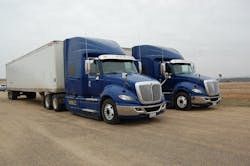NACFE documents low rolling resistance tire savings
The lower rolling resistance (LRR) of a truck or trailer tire, the greater the savings a fleet can achieve – even when the wear rate of an LRR tire is faster than that of “standard” model.
That’s the latest finding from a series of “confidence reports” authored by the North American Council for Freight Efficiency (NACFE).
The group’s study found that the cost of the fuel that a tire consumes due to its rolling resistance can be five times greater than the initial purchase price of the tire.
While the typical upfront purchase price of a tire is only approximately 4 cents per mile, given the range of rolling resistance among dual tires, NACFE’s research indicated that tires could actually account for anywhere from 14 cents to 28 cents per mile in fuel costs.
“Tires have a much bigger impact on overall fuel economy than many believe,” Mike Roeth, NACFE’s executive director, noted in a conference call with journalists.
Though he stressed that the price tag for LRR tires is “all over the map,” they by and large cost more than “standard” tire models – and that price premium “is usually minor; it’s not huge,” he added.
NACFE’s LRR confidence report also included two distinct total costs of operation or “TCO” analyses – one calculating the potential cost savings when moving from “standard” to “LRR” tires and the other moving from LRR to “super” LRR models.
In the first scenario – using a 80,000-lb. tractor-trailer operating 120,000 miles per year, with diesel fuel costing $2.80 per gallon, and using Goodyear “standard” and “LRR” models for comparison – NACFE’s data indicated a fleet could save $7,396 annually per truck.
In the second scenario – using the same tractor-trailer parameters but in this case shifting from Michelin-banded LRR tires to “super” LRR models – the group’s research indicated a fleet would save $2,680 per truck per year.
However, NACFE’s Roeth stressed that “super” LRR tires can be more expensive than their LRR brethren, due to the use of multiple and more costly rubber blends to achieve super-low resistance levels.
Yet he added that regardless of the scenario, fleets should save money by making such switch-outs when they are practical – accounting for duty-cycle, geography, and other operational characteristics.
“Clearly, tire choice has a huge impact on a fleet’s fuel expenditures and ultimately its bottom line,” Roeth said. “LRR tires in dual or wide-base configurations can reduce fuel consumption.”
About the Author
Sean Kilcarr
Editor in Chief
Sean Kilcarr is a former longtime FleetOwner senior editor who wrote for the publication from 2000 to 2018. He served as editor-in-chief from 2017 to 2018.
